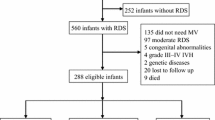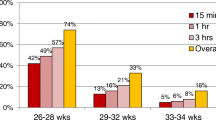Abstract
Neonatal ventilatory requirements and outcome were examined in 135 very preterm, small-for-gestational age (SGA) infants to determine whether fetal growth retardation protects against severe respiratory distress syndrome (RDS) in very immature infants. Their results were compared to those from gestational age-and gender-matched controls. Although there was no significant difference in the median duration of mechanical ventilation between the two groups, more SGA infants required ventilation and were ventilated because of RDS. In a subgroup also matched for mode of delivery, there was no significant difference between the proportion of SGA infants requiring mechanical ventilation for RDS compared to their matched controls. The mortality was greater in the SGA group. We conclude that fetal growth retardation does not protect against severe RDS.
Similar content being viewed by others
Abbreviations
- L:S ratio:
-
lecithin:sphingomyelin ratio
- RDS:
-
respiratory distress syndrome
- SGA:
-
small-for-gestational age
References
Blott M, Greenough A (1988) Oligohydramnios in the second trimester of pregnancy, fetal breathing and normal lung growth. Early Hum Dev 17:37–40
Blott M, Greenough A (1988) Neonatal outcome after prolonged rupture of the membranes starting in the second trimester. Arch Dis Child 63:1146–1150
Blott M, Greenough A, Nicolaides KH, Moscoso G, Gibb D, Campbell S (1987) Fetal breathing movements as predictor of favourable pregnancy outcome after oligohydramnios due to membrane rupture in second trimester. Lancet II:129–131
Brooke OG, McIntosh N (1984) Birthweight of infants born before 30 weeks gestation. Arch Dis Child 59:1189–1190
Bryan H, Hawry Iyshyn P, Hogg-Johnson S, Inwood S, Finley A, D'Costa M, Chipman M (1990) Perinatal factors associated with the respiratory distress syndrome. Am J Obstet Gynecol 162:476–481
Chandra RK (1979) Impairment of immunity in children with intrauterine growth retardation. J Pediatr 95:157–158
Chandra RS (1981) Serum thymic hormone activity and cell-mediated immunity in healthy neonates, preterm infants and small for gestational age infants. Pediatrics 67:407–411
De Lemos RA, Shermeta DW, Knelson JH, Kotes R, Avery ME (1970) Acceleration of appearance of pulmonary surfactant in the fetal lamb by administration of corticosteroids. Am Rev Respir Dis 102:459–461
Gairdner D, Pearson J (1988) Growth and development record G3P3. Castlemead Publications, Ware, UK
Gamsu HR, Mullinger BM, Donnai P, Dash CH (1989) Antenatal administration of betamethasone to prevent respiratory distress syndrome in preterm infants: report of a UK multicentre trial. Br J Obstet Gynaecol 96:401–410
Gluck L, Kulovich MV (1973) Lecithin/sphingomyelin ratios in amniotic fluid in normal and abnormal pregnancy. Am J Obstet Gynecol 115:539–546
Hackett GA, Campbell S, Gamsu H, Cohen-Overbeek T, Pearce JMF (1987) Doppler studies in the growth retarded fetus and prediction of neonatal necrotising enterocolitis, haemorrhage and neonatal morbidity. BMJ 294:13–15
Liggins GC (1969) Premature delivery of foetal lambs infused with glucocorticoids. J Endocrinol 45:515–523
Lin CC, Sheikh Z, Lopata R (1990) The association between oligohydramnios and intrauterine growth retardation. Obstet Gynecol 78:1100–1104
Merritt TA, Farrel PM (1976) Diminshed pulmonary lecithin synthesis in acidosis: experimental findings as related to the respiratory distress syndrome. Pediatrics 57:32–40
Nicolaides KH, Economides DL, Soothill PW (1989) Blood gases pH and lactate in appropriate and small for gestational age fetuses. Am J Obstet Gynecol 161:996–1101
Procianoy RS, Garcia-Prats JA, Adams JM, Silvers A, Rudolph AJ (1980) Hyaline membrane disease and intraventricular haemorrhage in small for gestational age infants. Arch Dis Child 55:502–505
Ruys-Dock van Heel I, Leeuw R de (1989) Clinical outcome of small for gestational age preterm infants. J Perinat Med 17:77–83
Shapiro R, Beatty DW, Woods DL (1981) Serum complement and immunoglobulin values in small for gestational age infants. J Pediatr 99:139–141
Villar J, Onis M de, Kestler E, Bolanos F, Cerezo R, Beinedes H (1990) The differential neonatal morbidity of the intrauterine growth retardation. Am J Obstet Gynecol 163:151–157
Yudkin PL, Abouaya M, Eyre JA, Redman CWG, Wilkinson AR (1987) New birthweight and head circumference centiles for gestational ages 24 to 42 weeks. Early Hum Dev 15:45–52
Author information
Authors and Affiliations
Rights and permissions
About this article
Cite this article
Thompson, P.J., Greenough, A., Gamsu, H.R. et al. Ventilatory requirements for respiratory distress syndrome in small-for-gestational-age infants. Eur J Pediatr 151, 528–531 (1992). https://doi.org/10.1007/BF01957761
Received:
Accepted:
Issue Date:
DOI: https://doi.org/10.1007/BF01957761




